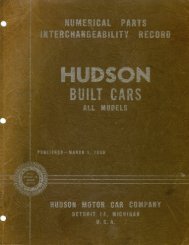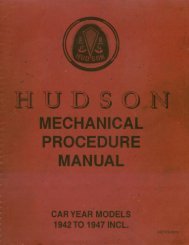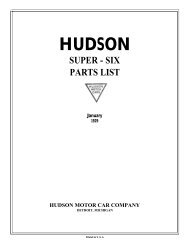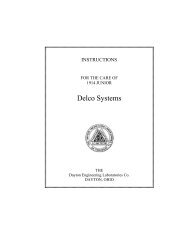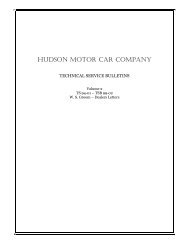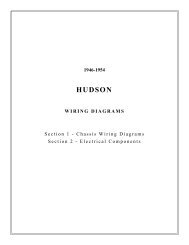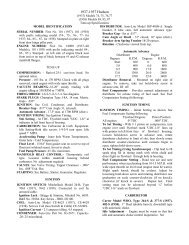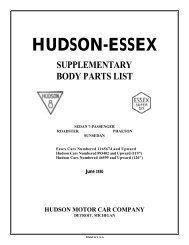1948-1952 Shop Service Manual - - Hudson-Essex-Terraplane Club
1948-1952 Shop Service Manual - - Hudson-Essex-Terraplane Club
1948-1952 Shop Service Manual - - Hudson-Essex-Terraplane Club
Create successful ePaper yourself
Turn your PDF publications into a flip-book with our unique Google optimized e-Paper software.
ELECTRICAL SYSTEM 6 - 17<br />
GENERATOR MOTORIZING DRAW:<br />
After generator is assembled and brushes properly fitted,<br />
the motorizing draw should be checked to assure proper<br />
assembly and alignment.<br />
1. Connect an ammeter and battery in series with the<br />
armature terminal and frame, Figure 11.<br />
2. Ground the field terminal to the frame.<br />
3. Connect a variable resistor in series with the battery and<br />
generator.<br />
4. Connect a voltmeter from the armature to the frame.<br />
5. Generator should operate as a motor with the armature<br />
turning slowly.<br />
6. Adjust voltage to 5 volts and read ammeter.<br />
7. Motorizing draw should be 3.9 to 4.4 amperes. If motorizing<br />
draw is higher, or armature does not turn, worn<br />
bearings, incorrect bearing alignment, short circuits, or<br />
improper assembly is indicated.<br />
GENERATOR CIRCUIT RESISTANCE CHECK:<br />
1. Disconnect battery lead at voltage regulator "B" terminal;<br />
connect the ammeter negative lead to the regulator "B"<br />
terminal and the positive lead to the wire disconnected<br />
from the regulator, Figure 13.<br />
2. Install the negative voltmeter lead to the generator "A"<br />
terminal and the positive voltmeter lead to the battery<br />
negative terminal.<br />
FIGURE 13<br />
3. Connect a jumper between the generator "F" terminal<br />
and a ground<br />
4. Run the engine at 2000 RPM or 20 amperes. The<br />
voltmeter should read not over .8 (tenths) or less.<br />
5. If the resistance is more than .8, make the following<br />
checks with the ammeter connected as in paragraph 1.<br />
A. Remove the positive voltmeter lead from the battery<br />
and Install to the "A" terminal at the voltage regulator.<br />
Ammeter should show less than .1 (tenth).<br />
B. Connect the voltmeter negative lead to the regulator<br />
"A" terminal and the voltmeter positive lead to the regulator<br />
"B" terminal. Ammeter should not show more than<br />
.3 (tenths).<br />
C. Next, connect the voltmeter positive lead to the battery<br />
negative terminal, negative lead to "B" terminal on<br />
regulator. Ammeter should not show more than .5<br />
(tenths).<br />
D. Connect the voltmeter positive leads to engine<br />
ground, negative wire to base of regulator. Ammeter<br />
should show .2 (tenths) or less.<br />
GENERATOR REGULATOR<br />
The generator regulator is a three unit, vibrating type<br />
current-voltage regulator consisting of a cutout relay, a<br />
current limiting regulator, and a voltage regulator.<br />
The cutout relay closes the circuit from the generator to<br />
the battery when the generator voltage reaches 6.3 to 6.8<br />
volts. The cutout relay opens the circuit when the generator<br />
voltage falls below 0 to 5 amperes reverse current.<br />
The voltage regulator unit operates when the generated<br />
voltage rises above the value for which it is set. (See<br />
"Specifications".) The voltage regulator controls the<br />
generator output by inserting resistance in the field<br />
circuit. The voltage regulator contact points open and<br />
close at high frequencies and hold the voltage at a<br />
constant value as long as the resistance of the circuit is<br />
high enough to keep it operating.<br />
The current limiting regulator operates in the same<br />
manner as the voltage regulator an d holds the generator<br />
output to the maximum safe value.<br />
The voltage regulator should he removed for overhaul<br />
or replacement only after other possible cause s of the<br />
trouble have been eliminated.



